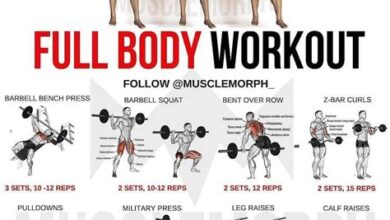How to Create a Sustainable Exercise Routine

Achieve your fitness goals with expert tips on understanding your fitness level, setting realistic goals, choosing activities, scheduling workouts, and tracking progress for effective results.Are you looking to establish a long-term exercise routine that is sustainable and effective? Creating a sustainable exercise routine is essential for maintaining a healthy lifestyle and achieving your fitness goals. In this blog post, we will explore the key components that will help you develop and maintain a sustainable exercise routine. From understanding your fitness level to setting realistic goals, choosing the right activities, scheduling workout sessions effectively, and tracking and adjusting your routine, we will cover all the necessary steps to ensure that your exercise routine is both enjoyable and beneficial. By following these guidelines, you can establish a routine that not only fits your lifestyle but also helps you stay motivated and committed to your fitness journey. Let’s dive in and learn how to create a sustainable exercise routine that works for you.
Understanding your fitness level
Before you can start on a sustainable exercise routine, it’s important to have a clear understanding of your fitness level. This involves assessing both your physical capabilities and your overall health. Consult with a healthcare professional or a fitness instructor to get an accurate assessment of your current fitness level. It’s also important to consider any existing medical conditions or injuries that may affect the types of exercises you can do.
Another aspect of understanding your fitness level is knowing your strengths and weaknesses. Take note of any physical activities that you enjoy and excel at, as well as those that you struggle with. Recognizing these aspects of your fitness level can help you tailor your exercise routine to your specific needs and preferences.
Understanding your fitness level also means being aware of your fitness goals. Whether you aim to improve your endurance, increase muscle mass, or simply maintain your current level of fitness, knowing your goals can help you choose the right exercises and track your progress effectively.
Setting realistic goals
When it comes to creating a sustainable exercise routine, setting realistic goals is key. It’s easy to get caught up in the excitement of starting a new fitness journey and set ambitious goals that may be difficult to achieve. However, it’s important to be honest with yourself and set goals that are achievable within your current fitness level and lifestyle. For example, if you’re just starting out, it may not be realistic to set a goal of running a marathon within the next few months. Instead, focus on setting smaller, attainable goals such as completing a 5k race or being able to do a certain number of push-ups. Setting realistic goals will help you stay motivated and avoid feelings of discouragement.
Another important aspect of setting realistic goals is taking into account your schedule and other commitments. If you have a busy work schedule or other responsibilities, it may not be feasible to commit to working out for an hour every day. In this case, setting a goal of working out for 30 minutes, three times a week might be more achievable. It’s important to be honest with yourself about what you can realistically commit to, and tailor your goals accordingly.
Lastly, it’s important to remember that progress takes time. While it’s great to set ambitious long-term goals, it’s also important to set smaller, short-term goals to help you stay motivated along the way. Celebrate the small victories and use them as motivation to continue working towards your larger goals. By setting realistic goals and acknowledging your current fitness level and lifestyle, you’ll be more likely to create a sustainable exercise routine that will keep you motivated and on track for the long haul.
Choosing the right activities
When it comes to creating a sustainable exercise routine, choosing the right activities is crucial. It’s important to find activities that you enjoy and that align with your fitness goals. Whether it’s jogging, weightlifting, swimming, or playing a sport, finding activities that you look forward to can make a huge difference in sticking to your routine.
Another factor to consider when choosing the right activities is your current fitness level. If you’re just starting out, it’s important to choose activities that are suitable for beginners. On the other hand, if you have been exercising for a while, you may want to challenge yourself with more intense activities.
Additionally, it’s important to consider the impact of the activities on your body. High-impact activities like running and jumping may not be suitable for everyone, especially those with joint issues. In such cases, low-impact activities like swimming or cycling may be a better choice.
Scheduling workout sessions effectively
When it comes to creating a sustainable exercise routine, scheduling your workout sessions effectively is crucial for long-term success. Many people struggle to stick to a regular exercise routine because they fail to set aside dedicated time for their workouts. This often leads to missed sessions and inconsistency, which can ultimately affect the results you see from your efforts.
Start by evaluating your daily schedule and identifying pockets of time where you can realistically fit in a workout. It could be first thing in the morning, during your lunch break, or in the evening. The key is to choose a time that works for you and stick to it consistently. By making exercise a non-negotiable part of your daily routine, you are more likely to prioritize and commit to it.
Additionally, consider the type of exercise you’ll be doing and how much time it typically requires. High-intensity workouts may only need 30 minutes, while longer sessions such as yoga or endurance training might require an hour or more. Be realistic about how much time you have available and plan your workouts accordingly. Setting realistic expectations for your schedule will help you stay on track and avoid feeling overwhelmed or discouraged.
Tracking and adjusting your routine
Once you have established a workout routine, it’s important to continuously track your progress and make adjustments as needed. Tracking your routine can involve monitoring your workouts, keeping a record of your performance, and noting any changes in your fitness level. This can be done through a fitness journal, a workout app, or simply by keeping a calendar of your exercise sessions.
By adjusting your routine as necessary, you can ensure that you are consistently challenging yourself and making progress towards your fitness goals. This might involve increasing the intensity of your workouts, trying new exercises, or altering the frequency of your sessions. It’s important to listen to your body and make changes that are sustainable and effective for you.
Remember that fitness is not a one-size-fits-all journey, and what works for one person may not work for another. Adjusting your routine to suit your individual needs and preferences is key to maintaining a sustainable exercise routine in the long term. By regularly tracking and adjusting your routine, you can stay motivated, avoid plateaus, and continue making progress towards your fitness goals.





